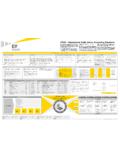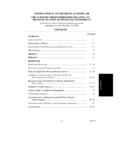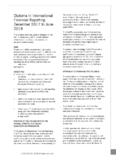Transcription of MASB Standard 6 The Effects of Changes in Foreign …
1 MASB 61 LEMBAGA PIAWAIAN PERAKAUNAN MALAYSIAMALAYSIAN accounting standards BOARDMASB Standard 6 The Effects of Changes in Foreign exchange RatesAny correspondence regarding this Standard should be addressed to:The ChairmanMalaysian accounting standards BoardSuite - , 5th Floor Wisma MaranNo. 388, Jalan Tuanku Abdul Rahman50100 Kuala LumpurTel : 03-4669199 Fax : 03-4669212E-mail address : address: 62 The Effects of Changes in Foreign exchange RatesContentsObjectiveScopeParagraphs1-6 Definitions7 Foreign Currency Transactions8-22 Initial Recognition8-10 Reporting at Subsequent Balance Sheet Dates11-12 Recognition of exchange Differences13-22 Net Investment in a Foreign Entity17-20 Allowed Alternative Treatment21-22 Financial Statements Of Foreign Operations23-40 Classification of Foreign Operations23-26 Foreign Operations that are Integral to theOperations of the Reporting Enterprise27-29 Foreign Entities30-38 Disposal of a Foreign Entity37-38 change in the Classification of a Foreign Operation39-40 All Changes in Foreign exchange Rates41 Tax Effects of exchange Differences41 Disclosure42-46 Transitional Provisions47-51 Effective Date52 Compliance with international AccountingStandardsAppendix 1 MASB 63
2 LEMBAGA PIAWAIAN PERAKAUNAN MALAYSIAMALAYSIAN accounting standards BOARDThe Effects of Changes in Foreign exchange RatesThe standards , which have been set in bold type, should be read in the contextof the background materials and implementation guidance in this Standard ,and in the context of the Foreword to MASB standards . MASB Standardsare not intended to apply to immaterial enterprise may carry on Foreign activities in two ways. It may havetransactions in Foreign currencies or it may have Foreign operations. In order toinclude Foreign currency transactions and Foreign operations in the financialstatements of an enterprise, transactions must be expressed in the enterprise sreporting currency and the financial statements of Foreign operations must betranslated into the enterprise s reporting principal issues in accounting for Foreign currency transactions and foreignoperations are to decide which exchange rate to use and how to recognise inthe financial statements the financial effect of Changes in exchange Standard should be applied:(a)in accounting for transactions in Foreign currencies.
3 And(b)in translating the financial statements of Foreign operationsthat are included in the financial statements of the enterpriseby consolidation, proportionate consolidation or by the Standard does not deal with hedge accounting for Foreign currencyitems other than the classification of exchange differences arising on aforeign currency liability accounted for as a hedge of a net investmentin a Foreign entity. Other aspects of hedge accounting , including thecriteria for the use of hedge accounting , will be dealt with in a proposedMASB Standard on Financial Instruments. This Standard , however, doesnot preclude the use of hedge accounting of transactions or exposedpositions covered by hedging Standard supersedes MASB Approved accounting Standard IAS21, accounting for the Effects of Changes in Foreign exchange rates ,and international accounting Standard IAS 21 (revised), The Effects ofChanges in Foreign exchange rates , issued previously by the Malaysianprofessional accountancy Standard does not specify the currency in which an enterprisepresents its financial statements.
4 However, under the provisions of 6(1)of the Ninth Schedule of the Companies Act 1965, all amounts in theprofit and loss (income statement) and balance sheet shall be quoted inMalaysian currency, and not Standard does not deal with the restatement of an enterprise sfinancial statements from its reporting currency into another currencyfor the convenience of users accustomed to that currency or for Standard does not deal with the presentation in a cash flow statementof cash flows arising from transactions in a Foreign currency and thetranslation of cash flows of a Foreign operation (see MASB 5, CashFlow Statements). following terms are used in this Standard with the meaningsspecified:Closing rate is the spot exchange rate at the balance sheet difference is the difference resulting from reporting thesame number of units of a Foreign currency in the reporting currencyat different exchange rate is the ratio for exchange of two value is the amount for which an asset could be exchanged, ora liability settled, between knowledgeable, willing parties in an arm slength currency is a currency other than the reporting currencyof an operation is a subsidiary, associate, joint venture or branchof the reporting enterprise, the activities of which are based orconducted in a country other than the country of the 65 Foreign entity is a Foreign operation.
5 The activities of which are notan integral part of those of the reporting items are money held and assets and liabilities to bereceived or paid in fixed or determinable amounts of investment in a Foreign entity is the reporting enterprise s sharein the net assets of that currency is the currency used in presenting the Currency TransactionsInitial Foreign currency transaction is a transaction which is denominated inor requires settlement in a Foreign currency, including transactions arisingwhen an enterprise either:(a)buys or sells goods or services whose price is denominated in aforeign currency;(b)borrows or lends funds when the amounts payable or receivableare denominated in a Foreign currency;(c)becomes a party to an unperformed Foreign exchange contract; or(d)otherwise acquires or disposes of assets, or incurs or settlesliabilities, denominated in a Foreign Foreign currency transaction should be recorded, on initialrecognition in the reporting currency, by applying to the foreigncurrency amount the exchange rate between the reporting currencyand the Foreign currency at the date of the exchange rate at the date of the transaction is often referred to asthe spot rate.
6 For practical reasons, a rate that approximates the actualrate at the date of the transaction is often used, for example, an averagerate for a week or a month might be used for all transactions in eachforeign currency occurring during that period. However, if exchangerates fluctuate significantly, the use of the average rate for a period 66 Reporting at Subsequent Balance Sheet each balance sheet date:(a) Foreign currency monetary items should be reported usingthe closing rate, except when there are related or matchingforward contracts in respect of trading transactions, in whichcase, the rates of exchange specified in those contracts shouldbe used;(b)non-monetary items which are carried in terms of historicalcost denominated in a Foreign currency should be reportedusing the exchange rate at the date of the transaction.
7 And(c)non-monetary items which are carried at fair valuedenominated in a Foreign currency should be reported usingthe exchange rates that existed when the values carrying amount of an item is determined in accordance with therelevant MASB standards . For example, certain financial instrumentsand property, plant and equipment may be measured at fair value or athistorical cost. Whether the carrying amount is determined based onhistorical cost or fair value, the amounts so determined for foreigncurrency items are then reported in the reporting currency in accordancewith this of exchange 15 to 18 set out the accounting treatment required by thisStandard in respect of exchange differences on Foreign currencytransactions. These paragraphs include the benchmark treatment forexchange differences that result from a severe devaluation or depreciationof a currency against which there is no practical means of hedging andthat affects liabilities which cannot be settled and which arise directlyon the recent acquisition of assets invoiced in a Foreign currency.
8 Theallowed alternative treatment for such exchange differences is set out inparagraph Standard does not deal with hedge accounting for Foreign currencyitems other than the classification of exchange differences arising on aforeign currency liability accounted for as a hedge of a net investmentin a Foreign entity. Other aspects of hedge accounting , including thecriteria for the use of hedge accounting and requirements for theMASB 67recognition of exchange differences and the discontinuance of hedgeaccounting, will be dealt with in a proposed MASB Standard on FinancialInstruments: Recognition and differences arising on the settlement of monetary itemsor on reporting an enterprise s monetary items at rates differentfrom those at which they were initially recorded during the period,or reported in previous financial statements, should be recognisedas income or as expenses in the period in which they arise, with theexception of exchange differences dealt with in accordance withparagraphs 17 and exchange difference results when there is a change in the exchangerate between the transaction date and the date of settlement of anymonetary items arising from a Foreign currency transaction.
9 When thetransaction is settled within the same accounting period as that in whichit occurred, all the exchange difference is recognised in that , when the transaction is settled in a subsequent accountingperiod, the exchange difference recognised in each intervening periodup to the period of settlement is determined by the change in exchangerates during that Investment in a Foreign differences arising on a monetary item that, in substance,forms part of an enterprise s net investment in a Foreign entity shouldbe classified as equity in the enterprise s financial statements untilthe disposal of the net investment, at which time they should berecognised as income or as expenses in accordance with enterprise may have a monetary item that is receivable from, orpayable to, a Foreign entity.
10 An item for which settlement is neitherplanned nor likely to occur in the foreseeable future is, in substance, anextension to, or deduction from, the enterprise s net investment in thatforeign entity. Such monetary items may include long-term receivablesor loans but do not include trade receivables or trade differences arising on a Foreign currency liabilityaccounted for as a hedge of an enterprise s net investment in aforeign entity should be classified as equity in the enterprise sfinancial statements until the disposal of the net investment, at whichtime they should be recognised as income or as expenses inaccordance with paragraph 68 Accordingly, the enterprise should denominate its Foreign equityinvestments in the appropriate Foreign currencies and translate thecarrying amounts at the closing rate.






